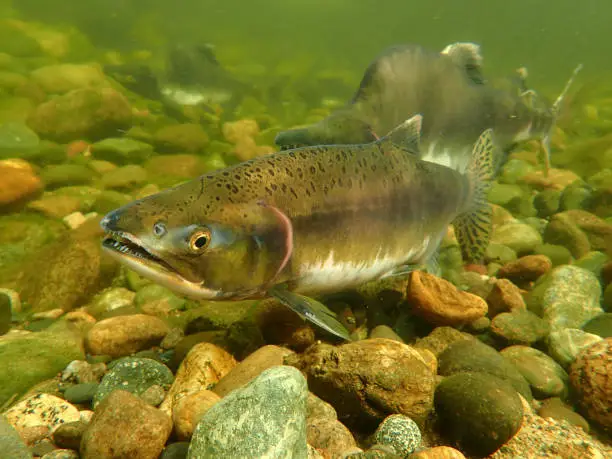General Description
Pink salmon are the smallest and most abundant Pacific salmon, typically weighing 3.5 to 5 pounds. They are coldwater fish harvested in Alaska since the late 1800s. Young pink salmon are silver, while adults have a greenish-blue back and silver sides. As they approach freshwater to spawn, males turn brown to black with large black spots and develop hump and hooked jaws, while females become olive green with dusky patches.
Table of Contents
Fast Facts
- Scientific Name
Oncorhynchus gorbuscha
- Size
20-25 Inches
- Weight
3.5-5 Pounds
- Habitat
North Pacific Ocean, coastal waters, and rivers from California to Alaska
- Diet
Zooplankton, small fish, and invertebrates
- Distinct Feature
Greenish-blue back, silver sides, small scales, pink flesh
- Predators
Larger fish like sharks, Bears, Eagles and Humans
- Reproduction
Female pink salmon lay between 1,200 to 1,900 eggs in freshwater nests, with males fertilizing them before both adults die, completing their two-year life cycle.
- Other Name
Humpback salmon, Humpy
About the Species

Taste
Pink salmon has a mild, delicate flavor, a slightly sweet taste, and a tender, flaky texture, making it versatile for various cooking methods.
Health Benefits
It is rich in omega-3 fatty acids, which promote heart health, reduce inflammation, and support brain function. It’s also a great source of high-quality protein, vitamins B12 and D, and essential minerals like selenium, all of which contribute to overall health and well-being.
Nutrition Facts
- Calories: 120
- Protein: 20g
- Fat: 4g
- Omega-3 Fatty Acids: 500-900 mg
- Cholesterol: 50mg
Classification and name origin
Pink salmon (Oncorhynchus gorbuscha) is named for its pink flesh and the hump males develop during spawning, with “gorbuscha” meaning “hump” in Russian.
Life History/Biology
These are anadromous, hatching in freshwater and migrating to the ocean to grow rapidly. After about 1.5 years, they return to freshwater from August to October to spawn, with females laying 1,200 to 1,900 eggs in nests before dying. They typically spawn at age two and follow an even or odd year cycle, depending on the population. Their diet includes crustaceans, zooplankton, and small fish, while they face predation from various birds, fish, and mammals. Salmon carcasses enrich river ecosystems, benefiting young salmon growth.
Availability
Pink salmon are primarily available from late summer to early fall during their spawning season, with fresh options in markets and canned or frozen varieties year-round. Most harvesting occurs in Alaska, with significant runs in odd-numbered years, though some regions also have even-year runs.
Is pink salmon sustainable?
Yes, pink salmon is generally considered sustainable, with many fisheries using responsible practices. To ensure sustainability, look for certifications like the Marine Stewardship Council (MSC).
FAQs
What is pink salmon?
Pink salmon, also known as Oncorhynchus gorbuscha, is a species of Pacific salmon known for its mild flavor and soft, pink flesh. It’s the smallest of the Pacific salmon species and is often used in canned or processed forms.
Where is pink salmon found?
It is typically found in the Pacific Ocean, especially along the coasts of North America and Asia. It primarily lives in cold, northern waters, migrating to rivers and streams to spawn.
What are the health benefits of pink salmon?
It is a nutritious source of protein, omega-3 fatty acids, and essential vitamins like B12 and D. It’s beneficial for heart health, brain function, and maintaining a balanced diet.
Is canned pink salmon healthy?
Yes, canned salmon is nutritious, offering similar health benefits as fresh salmon.
How should I store pink salmon?
Fresh fish should be refrigerated and cooked within two days or frozen for longer storage.






Any tips for seasoning pink salmon?
This is the lightest and freshest tasting salmon.
Tried pink salmon last night it was amazing!